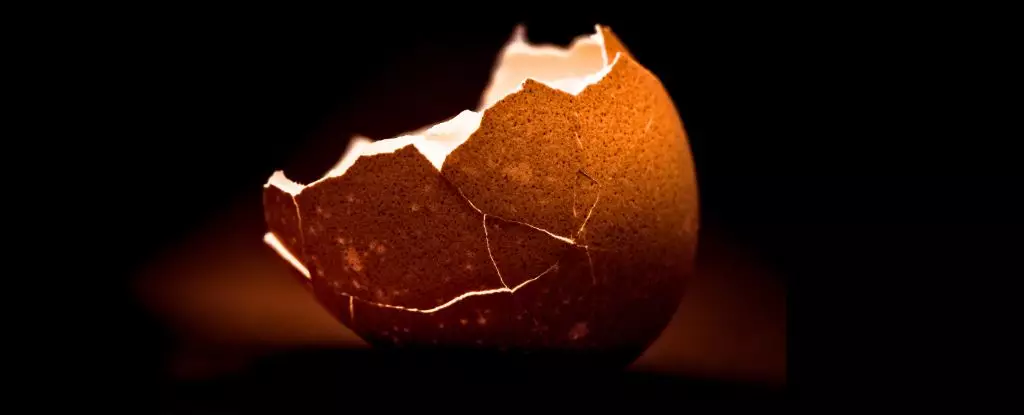There’s an unspoken culinary horror that has every home cook shuddering in anticipation: peeling a boiled egg. The frustration of removing a stubborn shell, along with the layers of membranous remnants clinging to the egg white, is all too relatable. It’s not merely a culinary annoyance; it’s a rite of passage that tests our patience in the kitchen. But the question remains: why is peeling boiled eggs such a universal struggle? Research has shed light on this predicament, revealing that the chemistry of the egg and its age play pivotal roles in peelability.
The Science Behind Hard-Boiled Eggs
Understanding the structure of an egg is crucial to unraveling the peeling mystery. A boiled egg is composed of a fragile shell that encases a liquid core—yolk and egg white—separated by two membranes. Between these membranes lies an air cell, which expands as the egg ages. This air pocket is instrumental in facilitating an easier peel, as the repeated exposure to the air increases the distance between the shell and the egg white.
Research dating back to the 1960s has indicated that the pH level of the egg white—more alkaline as it ages—can ease the peeling process. Fresher eggs typically possess lower pH levels, consequentially sticking more to their shells. An egg destined for boiling should ideally have a higher pH range, between 8.7 and 8.9, to limit the adhesion between the white and the shell.
Storage Conditions Matter
Beyond pH levels, where and how eggs are stored significantly impacts their peelability. A temperature of around 22 degrees Celsius (approximately 72 degrees Fahrenheit) is optimal for egg storage, providing superior results when it’s time for boiling. The refrigerator, while an imperative food storage solution, tends to lower the pH levels needed for easier peeling. Keeping eggs out of the cold can extend their lifespan, but at a risk of spoilage—the balancing act of culinary science.
Another factor to consider is the age of the egg. As eggs age, they lose moisture through the shell, increasing the air cell size. This expansion creates an initial gap that helps when working to peel the egg post-boiling. Additionally, the egg whites become more alkaline, enabling them to separate from the shell more easily—an essential tip for anyone looking to perfect their egg peeling techniques.
Boiling Techniques: Is Water Temperature Key?
Many seasoned chefs argue about the best method of boiling eggs. One popular technique involves starting with boiling water before lowering the temperature. This method ensures that high temperatures can ease the membrane separation from the egg white. Gentle acclimatization of eggs that are initially at room temperature protects them from cracking due to a sudden temperature shift and provides a superior outcome in peelability.
After boiling, how you treat the eggs matters. A sudden plunge into cold ice water can facilitate the separation of the egg white from the shell. This quick cooling method is thought to cause the egg white to contract slightly, thereby detaching from the shell.
Enhancements and Alternatives: Adjusting the Boiling Water
While there are various cooking methods to achieve perfectly boiled eggs, adding salt to boiling water for enhanced peelability remains a controversial topic. Some studies acknowledge a positive effect, while others suggest diminishing returns with prolonged storage. If you’re looking for a more effective method, consider adding baking soda or vinegar to your cooking water. These substances can manipulate the shell’s properties—baking soda increases alkalinity, while vinegar attacks the calcium carbonate structure of the eggshell, both aimed at aiding in easier peeling.
Beyond Boiling: Alternative Cooking Methods
Embracing alternative cooking methods can also yield satisfying results—pressure steaming, air frying, and even microwave techniques are viable contenders. For example, steam has shown potential in penetrating the eggshell and loosening the membrane. However, further research is warranted in these alternative cooking methods, particularly regarding air frying, which remains an enigmatic frontier in egg cooking techniques.
Utilizing Eggshells: Sustainability at Its Best
Once the eggshells are disposed of, it’s essential to rethink their potential uses. Rather than discarding them, they can serve various purposes—composting material, garden deterrents for slugs and snails, or even biodegradable pots for seedlings. In innovative realms such as cancer research, eggshells are finding experimental applications. This highlights a crucial lesson in sustainability and resourcefulness that extends beyond just perfecting the art of peeling eggs; it encourages us to utilize every part of our ingredients creatively and purposefully.
In the end, conquering the challenge of egg peeling is a journey that combines scientific understanding, practical techniques, and a sprinkle of creativity. By embracing the principles behind the perfect peel, cooks can transform this culinary annoyance into an art form.


Leave a Reply